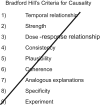Post-Modern Epidemiology: When Methods Meet Matter
- PMID: 30877306
- PMCID: PMC6670067
- DOI: 10.1093/aje/kwz064
Post-Modern Epidemiology: When Methods Meet Matter
Abstract
In the last third of the 20th century, etiological epidemiology within academia in high-income countries shifted its primary concern from attempting to tackle the apparent epidemic of noncommunicable diseases to an increasing focus on developing statistical and causal inference methodologies. This move was mutually constitutive with the failure of applied epidemiology to make major progress, with many of the advances in understanding the causes of noncommunicable diseases coming from outside the discipline, while ironically revealing the infectious origins of several major conditions. Conversely, there were many examples of epidemiologic studies promoting ineffective interventions and little evident attempt to account for such failure. Major advances in concrete understanding of disease etiology have been driven by a willingness to learn about and incorporate into epidemiology developments in biology and cognate data science disciplines. If fundamental epidemiologic principles regarding the rooting of disease risk within populations are retained, recent methodological developments combined with increased biological understanding and data sciences capability should herald a fruitful post-Modern Epidemiology world.
Keywords: Bradford Hill; causal inference; history of epidemiology; liability models; methodology; stochasticity.
© The Author(s) 2019. Published by Oxford University Press on behalf of the Johns Hopkins Bloomberg School of Public Health.
Figures




Similar articles
-
Evolution of epidemiologic methods and concepts in selected textbooks of the 20th century.Soz Praventivmed. 2004;49(2):97-104. doi: 10.1007/s00038-004-3117-8. Soz Praventivmed. 2004. PMID: 15150860
-
[Causal inference in epidemiology].Rev Salud Publica (Bogota). 2017 May-Jun;19(3):409-415. doi: 10.15446/rsap.v19n3.66180. Rev Salud Publica (Bogota). 2017. PMID: 30183950 Spanish.
-
Interaction and evolution in epidemiology.Soz Praventivmed. 2004;49(2):105-6. doi: 10.1007/s00038-004-0044-7. Soz Praventivmed. 2004. PMID: 15150861 No abstract available.
-
Statistical Reasoning and Methods in Epidemiology to Promote Individualized Health: In Celebration of the 100th Anniversary of the Johns Hopkins Bloomberg School of Public Health.Am J Epidemiol. 2016 Mar 1;183(5):427-34. doi: 10.1093/aje/kwv453. Epub 2016 Feb 10. Am J Epidemiol. 2016. PMID: 26867776 Review.
-
Paradigms in epidemiology textbooks: in the footsteps of Thomas Kuhn.Am J Public Health. 1999 Aug;89(8):1162-5. doi: 10.2105/ajph.89.8.1162. Am J Public Health. 1999. PMID: 10432899 Free PMC article. Review.
Cited by
-
Mendel's laws, Mendelian randomization and causal inference in observational data: substantive and nomenclatural issues.Eur J Epidemiol. 2020 Feb;35(2):99-111. doi: 10.1007/s10654-020-00622-7. Epub 2020 Mar 23. Eur J Epidemiol. 2020. PMID: 32207040 Free PMC article.
-
Sex ratio and age of onset in AQP4 antibody-associated NMOSD: a review and meta-analysis.J Neurol. 2024 Aug;271(8):4794-4812. doi: 10.1007/s00415-024-12452-8. Epub 2024 Jul 3. J Neurol. 2024. PMID: 38958756 Free PMC article.
-
Bann and Aksoy Respond to "Religious Service Attendance and Public Health".Am J Epidemiol. 2022 Jan 1;191(1):36-37. doi: 10.1093/aje/kwab135. Am J Epidemiol. 2022. PMID: 33977299 Free PMC article. No abstract available.
-
Chance, ignorance, and the paradoxes of cancer: Richard Peto on developing preventative strategies under uncertainty.Eur J Epidemiol. 2023 Dec;38(12):1227-1237. doi: 10.1007/s10654-023-01090-5. Epub 2023 Dec 26. Eur J Epidemiol. 2023. PMID: 38147198
-
Interpreting Mendelian-randomization estimates of the effects of categorical exposures such as disease status and educational attainment.Int J Epidemiol. 2022 Jun 13;51(3):948-957. doi: 10.1093/ije/dyab208. Int J Epidemiol. 2022. PMID: 34570226 Free PMC article.
References
-
- Morris JN. Uses of Epidemiology. Edinburgh, UK: Livingstone; 1957.
-
- Davey Smith G. The uses of “Uses of Epidemiology”. Int J Epidemiol. 2001;30(5):1146–1155. - PubMed
-
- MacMahon B, Pugh TF, Ipsen J. Epidemiological Methods. Boston, MA: Little Brown; 1960.
-
- Greenwood M. Epidemics and Crowd Diseases: An Introduction to the Study of Epidemiology. London, UK: Williams and Norgate Ltd; 1935.
-
- Taylor I, Knowelden K. Principles of Epidemiology. London, UK: J&A Churchill; 1957.

